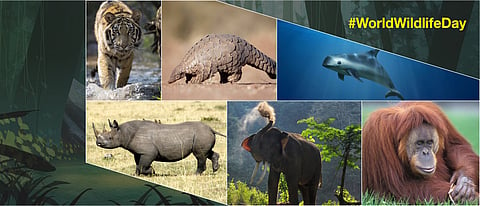

Mother Earth is an abode for various species. The wildlife provides stability to earth’s functioning, helping it maintain the balance of nature. Earth has lost more than half its biodiversity in the last four decades. World Wildlife Day, celebrated on March 3, is an opportunity to celebrate the world’s wild flora and fauna, and the benefits of a bio-diverse world. The theme for 2020 is: “sustaining all life on earth”.
The day reminds us of our individual responsibility to protect the ecosystems from destruction for natural resources, and of the need to fight against wildlife crime, over-exploitation, habitat loss, illegal trade, and all threats that affect animal and plant species around the world.
Today the loss of species is estimated to be between 1,000 and 10,000 times than that of the natural extinction rate. WWF reports that between 0.01% and 0.1% of all species go extinct every year. Considering the fact that there are around two million species on the planet, it means between 200 and 2,000 extinctions occur every year. And note, we are talking about species of which humans are one.
As per the 2018 report of World Wildlife Foundation (WWF), there’s a 60% decline in the population of mammals, birds, fish, reptiles, amphibians in just 40 years. As per the IUCN Red List, more than 30,000 species are threatened with extinction, which means 27% of the nearly 1,12,000 species accessed so far are under grave danger. Segregating it further the threat table looks like:
| 41% | Amphibians |
| 25% | Mammals |
| 34% | Conifers |
| 14% | Birds |
| 30% | Sharks and rays |
| 33% | Reef corals |
| 27% | Selected crustaceans |
LET US LOOK AT SOME OF THE ENDANGERED ANIMALS:
PANGOLIN
Pangolin, depending on its specie, have large protective scales covering their skin, and they are the only known mammals with this feature. They live in hollow trees or burrows and feed on ants and termites, which they capture using their long tongue. A total of eight species are found on the two continents of Asia and Africa. All eight species are protected under national and international law.
RHINOCEROS
Rhinos are large herbivorous mammals. There are five species and eleven subspecies. Some have two horns, others one. Due to its medicinal properties, the horns – which are also used as trophies and decorations – are in high demand.
Black rhino, Sumatran rhino and Javan rhino are critically endangered species. Due to habitat loss and poaching, the Sumatran rhinos are on the verge of extinction with less than 75 remaining in the world.
TIGER
Tigers are considered as one of the world’s most threatened animal species. They are globally listed as endangered. One of the main reasons why tigers are endangered is because of illegal hunting for their pelts and body parts used in folk medicines. South China tiger and Sumatran tiger are the most critically endangered sub-specie. Around500 Sumatran tiger exists today worldwide.
VAQUITA
Vaquita, the world’s rarest marine mammal, is on the edge of extinction. The population has dropped drastically in the last few years. The Vaquita has a large dark ring around its eyes and dark patches on its lips that form a thin line from mouth to pectoral fins. They are found in Mexico’s northern Gulf of California. The world has less than 100 vaquitas today.
SUMATRAN ELEPHANT
Sub-species of the Asian elephant, Sumatran elephant, are the largest terrestrial animals of Indonesia. It is listed as a critically endangered species. They have suffered an 80% depletion in population during the past three generations with poaching being one of the primary reasons.
ORANGUTAN
The word orangutan means the ‘man of the forest’. Orangutans face extinction due to deforestation and forest fires in the tropical rainforests in regions like Borneo and Sumatra. Orangutans are among the most intelligent non-human primates. Experiments suggest that they can figure out some invisible displacement problems with a representational strategy.
The continued existence of wildlife and wilderness is vital for the ecosystem and the quality of human lives.
